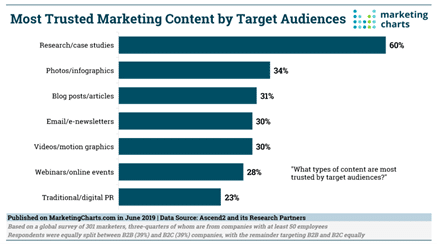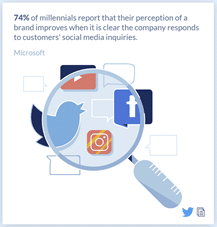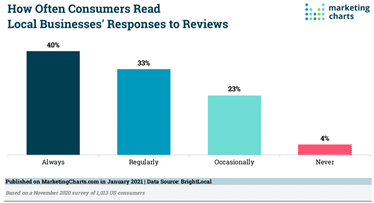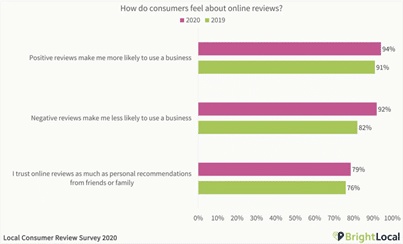There’s a reason that brand awareness and brand trust are so important in every industry.
Brands tell consumers what they can expect from a product, and consumers remember the brands they like — and don’t like.
When considering making a purchase, 81% of buyers think about the brand and assess it as either a reason for buying or a deal-breaker. Having trust in a brand influences consumers at every income level, age, geographical location, and gender.
It’s also becoming clear that brand trust is getting more important as a factor in buying. Consumers cite issues like automation and the brand experience with the product in making brand trust more important.
Download this post by entering your email below
What Is Brand Trust?
Brand trust makes up more than just trust that the brand’s product will be a good one. It also encompasses the entire experience that customers have with the brand, from buying to using the product.
When consumers trust a brand, there are three main factors that are important for them to build confidence and trust in the brand.
The first of these is being open and honest. The second is being inclusive and respectful, and the third is caring for customers and being able to identify with them.
These factors are important even if the brand is a new one. Brands that develop these three factors in a stronger way will do better than their competition when it comes to building brand value.
With consumers, having trust in a brand both reassures them that it is a good purchase and makes it simpler to choose among brands.
Today’s public is more and more concerned with corporations behaving in a more responsible manner, and this is pushing brands to add positive actions to their brand trust strategies.
Right now, there is the opportunity to earn trust while engaging in positive actions, but it’s only true as long as the public sees these actions as actually being altruistic.
The brand has to have empathy and sincerity to have these actions seen as altruistic. And the company must stay consistent with these values to build its valuable reputation.
Consumers also have a growing worry about the way that their data is being used. This is considered a part of the brand experience, even if it comes later after the purchase.
Brands need a clear privacy policy and to be transparent with the ways that data is being used.
Why Is It Important for Successful Businesses?
Trust has always been a part of a brand’s story. The amount of trust that the brand can command has long been associated with how successful it is in the marketplace.
One difference today is that people can spread their impressions of and experiences with a brand far and wide online.
Potential customers can check the online reviews of a product or a brand itself and see how others have felt about their purchase.
This has made it more important than ever to create a good customer experience so that brand trust doesn’t take a nosedive due to online reviews.
Buyers today have far more expectations for the brands they choose, and their overall level of trust depends on a number of different factors other than simply whether the product works well for them.
Though that is the main factor, consumers also want more from the companies they buy from.
When a consumer trusts a brand, he is 53% likely to try its newest products. Among brands where there isn’t trust, only about 25% are likely to buy that brand’s new products.
When they trust a brand, they have more than double the likelihood of being loyal to that brand. They are also about twice as likely to advocate for the brand with others.
Buyers are turning away from the marketing methods that have been the standard for decades and instead relying on social media or each other to decide what to buy and whether to trust it.
In fact, getting input from other consumers is so important to today’s buyers that they will read 100 reviews on average before they have enough confidence to buy an item online.
Getting those positive reviews through quality and the customer experience is of the utmost importance in today’s marketplace.
What Are the Main Pillars of Brand Trust?
In any relationship, trust is the cornerstone to its success. So, what are the key elements to establishing trust with your audience? This may also help in your personal relationships too, but don’t hold me to it.
Pillar 1: Perceived Ability
Is your brand able to do what it promises? This is the question your audience will ask. Does what you say and what you do match up or are you all smoke and mirrors?
By reassuring your audience through performing the actions you claim, you will build trust and start to create advocacy.
Social proof or reviews will also help to strengthen this trust, just don’t overpromise and under-deliver.
Pillar 2: Perceived Benevolence
Do they care about me? Yes, this is a tough one to establish.
By being consistent in your messaging and communication with the consumer, you will prove to them, you care about what they say.
Build timeframes into your strategy for responding to online comments, engage with your consumers, and always respond if they have a problem or negative experience.
Pillar 3: Perceived Integrity
Having a set of values that your target audience agrees with is important. By demonstrating you share values, you will strengthen trust. After all, we all like people who share the same beliefs as ourselves.
Are your products produced ethically? Do you help the community? Do you look after stray puppies? Let your audience know through your advertising.
How Can To Increase Brand Trust?
This is no easy task and not for the faint-hearted. Gaining someone’s trust takes time and persistence. It’s all about consistency. If you want to take your brand to the next level, building brand trust is the way to success.
So how do you increase your brand trust?
Here are seven steps that you can follow to secure your path towards brand advocacy.
1. Create Clear and Measurable Goals
Whether you’re planning to climb Mount Everest or increase your company’s brand advocacy, having clear and definable goals is vital to your success.
After all, if you don’t know where the goalposts are, how are you going to reach your target?
Do you want more visitors to your website? How about increasing your social media following? Is gaining a boatload of email addresses what you should aim for? Do you want to create more brand awareness and advocacy?
Create a plan which includes clear and measurable goals. These goals should be communicated to other employees, as a unified approach is a realistic approach, and a realistic approach will be the building blocks to establishing trust.

You will need to measure your target audience’s reaction by utilizing tools such as Google Alerts for social mentions. Also keep an eye on industry-specific review sites such as Yelp, Zillow, Trust Pilot, or your Google Business page.
There are companies that provide services to monitor these from one platform such as Hootsuite.
You can also ask your audience by sending feedback requests using tools such as Survey Monkey, find out your Net Promoter Score, or customer satisfaction surveys.
2. Choose a Brand Trust Lead
Although this is not always possible, appointing a captain of the trust ship is a great way to communicate you are serious about change.
Having someone dedicated (and accountable) to creating trust, setting goals, and measuring effectiveness is a sure-fire pathway to success.
3. Be Authentic and Present
The days of fooling a target audience with your sales pitch and a truckload of benefits are over. Your audience is far too media savvy. They want to know who you are and what you stand for.
This can be done in two ways. First, you need to create a brand story.
Create your brand’s own unique story, to communicate your values and voice. This shouldn’t have anything to do with profit and maybe not even about your products.
Second, be present and own your good, and you’re bad. Trust and authenticity go hand in hand, and it is easy to see through an unauthentic message.
If you make a mistake or receive a customer complaint, own it. That act alone will make you real and create advocacy.

Put processes in place to enable quick reaction and response to any negative feedback.
4. Aim for a Consistently Mind-Blowing Customer Experience
From the first time a consumer sees your Facebook post, to visiting your website, to carrying a shopping bag with your branding on the side, they are on a journey with your brand.
This customer experience needs to be as streamlined and as mind-blowing as possible at every touchpoint.
A great way to improve this experience is by mapping your customer’s journey. By visualizing the events both before and after a purchase, you can identify and improve any opportunities to enhance the relationship.
5. Focus on Building Relationships Rather Than Making Conversion
Easier said than done I know. In today’s highly competitive marketplace, it all comes down to the dollar.
However, the latest stats are showing a different story. Consumers are shifting toward brands that ‘get them.’
They are searching for affiliation with where they spend their money. This is why the rise of the influencer has been so prolific, they connect with their audience so well. Their followers feel valued.

Create an experience blueprint and treat each new customer as a VIP. Then continue to build on the relationship.
6. Welcome Transparency
It’s pretty clear that transparency is a key to building trust, in any relationship.

By showing consumers the truth about your products, supply chain, and company values, you are providing a transparent experience.
They will then decide if your brand is for them. They may not take your word for it, you will have to prove it to them.
Up to 58% of consumers won’t believe a brand until they have proof, social or personal. This can be done by divulging secret ingredients, responding to social media comments quickly, or displaying both negative and positive reviews in public. This brings us to our final stage.
7. Build Social Proof
Social proof is the equivalent of recommending your favorite electrician to your neighbor.
With 87% of consumers reading company reviews and their responses to make their purchasing decisions, this is a crucial facet of your marketing strategy.

Reviews about your offerings, both good and bad, create a level of confidence in your brand amongst consumers. In fact, the way you respond to negative reviews can create a level of realism that will sway the consumer into a purchase.

However, the task of keeping up with expectations can be grueling. With 73% of consumers only taking note of reviews written in the last month, 48% of consumers expecting a response to social media comments within 24 hours, and 18% expecting a response within 1 hour, this is an element that needs careful management.
There are tools available such as Mentions that allow you to monitor an array of consumer communication from various platforms from one location.
Perform these steps, be adaptable and consistent in your approach, and you will begin to build a loyal fan base.
Some Steps to Follow to Build Brand Trust
People don’t have a default for brand trust. Only about one-third of respondents trust the majority of the brands that they bought and used.
Trust is basically a relationship, and that relationship begins by getting what they want from the product. As with any other type of trust-built relationship, there are some rules to follow.
First, your company needs to find out the sentiment toward its brand. If it is a good one, ways to improve it can be found. If it is a bad one, there is a lot of work to do on turning its reputation around.
To understand the reputation it currently has, employ a few ways to get customer feedback and use that feedback to understand the reasoning behind it.
One way to do this is to look at online reviews. You can also assess mentions on social media. There should also be a feedback opportunity on the brand’s website that makes it easy to send comments.
Then, create a better customer experience. Each interaction that a customer has with a brand affects their total customer experience.
Any time they have to contact the brand, ask a question, return a product, etc., their customer experience is being shaped. It’s the job of today’s brands to deliver the best customer experience possible.
This allows the brand to get a higher number of good reviews, to reduce the numbers of complaints and bad reviews, and to increase satisfaction with the brand as well as loyalty.
Next, have a social media presence in place, and don’t neglect it. Today’s buyers don’t get attached to ads if they aren’t already aware of its brand.
When they are thinking of buying something new, they go to social media. Every company’s target audience is located on social media, so your brand should be there as well.
Posting should be helpful to consumers, with plenty of useful information as well as plenty of conversations going on.
One of the quickest ways to build brand trust is to maintain a presence on social media where customers can ask questions.
After that trust has been built, consumers will then notice your ads. It takes having your brand’s name on three channels for the trust to begin to build. If your social media messages are of high quality and are consistent, people will associate that with the brand.
Then, use user-generated content. Instead of running off any use of your brand’s image or products, embrace this type of content.
This can go a long way toward building a good reputation. It may be a tweet about your product, a video on YouTube, a written review, or a picture posted on Instagram. It’s all valuable content that can be used to build trust.
Engaging with customers about this content can be a useful tool to increase engagement with the brand. Link to, like, or repost positive content that comes from customers.

Keep your brand honest and transparent and, above all, authentic. Trying to game the system to build trust is easily seen through by consumers.
If a brand has nothing but great reviews, this may be seen as inauthentic, as no one likes every single brand they try.
It is also a sign of “trustwashing,” and that loses a customer’s trust instantly. Getting rid of negative reviews leaves customers wondering what else the brand has to hide. Address negative reviews rather than trying to erase them.
Seeing that a company cares about a poor customer experience is another way of building trust in the brand.
Be sure that your attempts to bring in customers are honest and that you don’t appear to be doing everything possible to sell the product. This may be seen as inauthentic. Make your business open to online reviews by making sure it is on business websites that gather opinions.
More than 63% of customers look at reviews on Google before they go to a business. And, almost 90% of consumers want a real person’s recommendation rather than Siri or Alexa.
Be consistent with your brand. Any other trust that you’ve built won’t mean much if the product is inconsistent.
Part of this consistency is creating a brand identity that is immediately apparent visually and establishing a personality for the brand that includes a consistent message.
The words you choose and the visual aspect of the brand together make the personality of the brand. The message that is put out by your brand has to be consistent across each channel that it uses.
This includes messages on the packaging, in marketing emails, on social media, and on your main website.
Everyone who works for the company should put forth the company’s branding, wearing its logo, using its voice, posting messages in its font, and having a consistent tone.
Being consistent also means not making constant changes to the brand without significant brand research being done.
Your brand’s consistency also has to do with the frequency of its communications. One way to keep building brand trust and loyalty is to send out a useful newsletter at regular intervals so that customers are reminded of your brand.
Specialist Ivory Research says this is necessary to try to make these messages as personal as possible and give readers a reason to look at your latest messages. When your brand’s voice and design are consistent, they become familiar to their target audience.
Companies also have to understand the behavior of their customers. Today’s customers depend on reviews, descriptions, and images of products to make up their minds about what to buy and where to go to eat.
They want to feel that brands understand them, and there are several things they use to gauge whether that’s the situation. They want to see reviews from people who are like themselves, they want to get recommendations for items that are relevant to them, and they want to have their purchase history remembered, among other factors.
When you can personalize the experience, there is more of a connection between the customer and the brand.
Brands That Are Doing It Right
As trust and loyalty go hand in hand, let’s look at some brands that are creating brand trust very well.
Home Depot
By showing thanks to their staff and reiterating how they helped the community during the pandemic, they successfully aligned with many Americans’ values. They shared their story and showed vulnerability to instill trust and an emotional connection.
These guys know how to connect with their audience through storytelling. Although they have slipped this past year from 2 to 6 on the loyalty ladder, they continue to reiterate that their service is an essential part of life.
Amazon
This campaign is a masterpiece and I challenge you not to tear up while watching it. It links into so many social issues while connecting with us all in the pandemic situation. It screams ‘we are all in this together,’ and Amazon is here to help you.
More Work to Build Brands
It may seem like it takes more work today to build a brand and grow trust from customers. It is true that there are more ways to build that trust and that customers expect more of today’s brands.
However, the internet, and social media, in particular, have made it possible for tiny brands to grow into giant ones thanks to the exposure they get.
The power of reviews can be harnessed to prove to customers what they can expect from you and why they should buy. The link between trust and purchasing is a strong one, so that trust-building needs to be a part of your brand’s plan from day one.
How do you want the public to experience your brand? You can make it a better experience when you understand the power of content. Download the 5th issue of our Magazine and learn more about content experiences!



![[ROCK NA] [EBOOK SEO] Complete Guide](https://rockcontent.com/wp-content/uploads/2024/06/banner_Search-Engine-Optimization.png)






